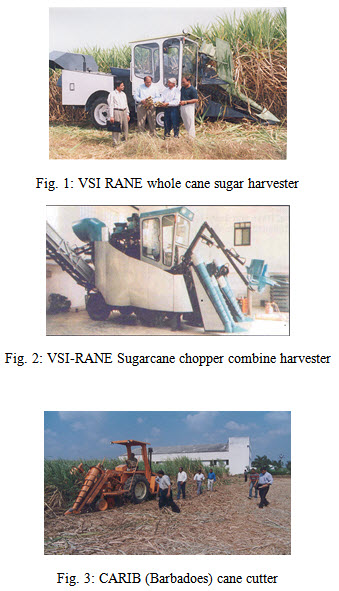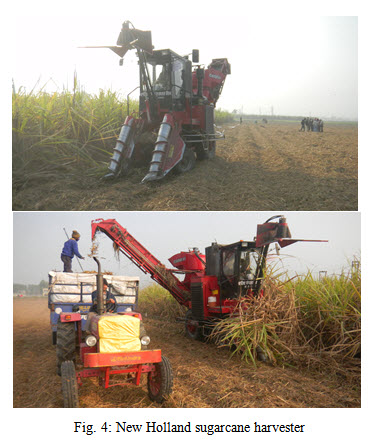Site pages
Current course
Participants
General
MODULE 1. PRINCIPLES AND TYPES OF CUTTING MECHANISM
MODULE 2. CONSTRUCTION AND ADJUSTMENT OF SHEAR AND...
MODULE 3. CROP HARVESTING MACHINERY
MODULE 4. FORAGE HARVESTING, CHOPPING AND HANLING ...
MODULE 5. THRESHING MECHANICS, TYPES OF THRESHES, ...
MODULE 6. MAIZE HARVESTING AND SHELLING EQUIPMENT
MODULE 7. ROOT CROP HARVESTING EQUIPMENT
MODULE 8. COTTON PICKING AND SUGARCANE HARVESTING ...
MODULE 9. PRINCIPLES OF FRUIT HARVESTING TOOLS AND...
MODULE 10. HORTICULTURAL TOOLS AND GADGETS
MODULE 11. TESTING OF FARM MACHINES, RELATED TEST ...
MODULE 12. SELECTION AND MANAGEMENT OF FARM MACHIN...
LESSON 21. SUGARCANE HARVESTERS - DESIGN CRITERIA
Design criteria
Following points cover the expectations of the farmers/users;
-
Sugarcane harvester should be able to cut the whole cane from base, detrash it, detop it and may put the cut cane in the container attached behind or may windrow the cut crop.
-
Row to row spacing be adjustable to cut cane grown at a spacing of 60 to 150 cm.
-
The sugarcane harvester to be developed should preferably be operated by 70 to 80 hp tractor.
-
The capacity of machine should be 1.5 to 2.0 ha/day or even more.
-
The cost of the machine should be within Rs. 25-30 lakhs with total cost of harvesting operation less than Rs. 150 per tonne (Including base cutting, detrashing and detopping).
-
The machine should be light in weight with low turning radius.
-
Trash content should not be more than 5%.
While designing the sugarcane harvester agronomical practices followed in the different parts of the country and other details as given below should be kept in mind:
(i) Agronomical practices followed in the different part of the country
(ii) Height of cane (range)
(iii) Stem diameter of cane (range)
(iv) Row-to row spacing beig followed (range)
(v) Moisture content during harvesting (range)
(vi) Method of planting- Ridge planting or flat planting
(vii) Lodging conditions
(viii) Expectations of the farmers/users about field capacity, speed, price and cost of operation
Recently Heera Sugar Industries village Sherewad, Sangheshwar District Belgaum claimed to develop single row whole cane sugarcane harvester operated by 60 hp tractor. The machine cuts the crop, detopps, de-trashes, collects the whole cane on the rear and deloads at one place while operating in the field. About 80 acres crop was harvested. The unit developed has been patented as informed by the firm. Machine is suitable for sugarcane crop with row to row spacing of 3 feet.
The Single row Self-propelled whole cane sugarcane harvester was developed and demonstrated at the farm of Mr. Pratap Rane near Pune (Fig. 1). The performance of machine was satisfactory. The following points emerged from the demonstration:
(i) The forward speed of machine was very low and hence the field capacity of machine. The field capacity of machine was 1.0 ha/day only.
(ii) Frequent back and fro was observed during operation.
(iii) Trolley at back was swinging towards right and hence posed the balancing problem.
(iv) Choking of cane in trolley was observed.
(v) Cutting of cane tops was not proper mainly because of cane guides were far apart and cane height was not uniform.
(vi) Though the cane detrashing was satisfactory, however trash cleaning was not proper and needs blower speed adjustments.
Further the Billet type sugarcane harvester developed under NATP scheme by M/s Rane Agro Pvt. Ltd., Pirangut, Pune in collaboration with ICAR and VSI Pune was demonstrated (Fig. 2). The following points emerged from the demonstration:
-
The forward speed of machine was very low and hence the field capacity of machine was 1.0 ha/day only.
-
Cutting of cane tops was not proper mainly because of cane guides were far apart and cane height was not uniform.
-
Though the cane detrashing was satisfactory, however trash cleaning was not proper and needs blower speed adjustments.
-
There was damage to crop by tractor tyre on the left of tractor.
Sugarcane combine harvester: In this system, sugarcane is cut first from the top and then from the base and it is cut into billets and is loaded in transport cart. It does not required separate loader for loading purpose. The machine consists of gathering mechanism, detopping mechanism, base cutter, feed conveyor, chopper, and elevator and cleaning unit (Fig. 3). The machine is generally powered by the engine of 150 hp. Pre-harvest burning is being practiced where harvester is to be used. Mostly it can harvest cane grown at a row-to-row distance of 90 cm. The average capacity of the machine is about 0.4 ha/h. It is most sophisticated machine among all types of sugarcane harvesters.
Engine operated sugarcane leaf stripper: This is a portable engine operated machine used for the detrashing and leaf stripping from whole cane. The sugarcane without leaf require less space for storage as well as transportation.
Whole stalk sugarcane harvesters: These harvesters are quite suitable for those areas where sugarcane crushing is not possible within short period of harvesting. Delay during transport, loading, unloading, waiting at one or the other stage is unavoidable. Use of whole stalk sugarcane harvesters is also useful for those areas where green tops recovered are used for cattle feed. Such machines are either tractor operated or self propelled. Introduction of such machines in phases is possible even in those areas where sugarcane is not lodged, canes may be bent up to 10 - 150. There are only few designs of whole stalk harvesters in use in the world because of difficulty in handling of lodged cane by these machines. Therefore, whole stalk harvesters with base cutting, de-topping and partial de-trashing for erect, medium to low tonnage crop areas may be introduced, especially under those locations where self stripping / erect type cane varieties are common. Windrowing type harvesters (Fig. 3) may be backed up by grab loaders. These machines includes Case Austoft, Moller bin type, Cameco whole stalk, tractor operated Carib, Bonnel & Bunmai harvester windrower. Presently production of this type of machine is almost stopped.
A system of chopper harvester consists of one chopper harvester of a particular capacity and size, two articulated trailers of 4-5 tonne capacity (depending upon the site), transport trucks of 8-10 tonne capacity and mobile repair van along with spare parts (Fig. 4). Complete package of these machines cost in the range of 110 to 170 lakhs depending upon the specifications of the harvester. These machines may be introduced in phases without affecting the existing system of sugarcane management.

